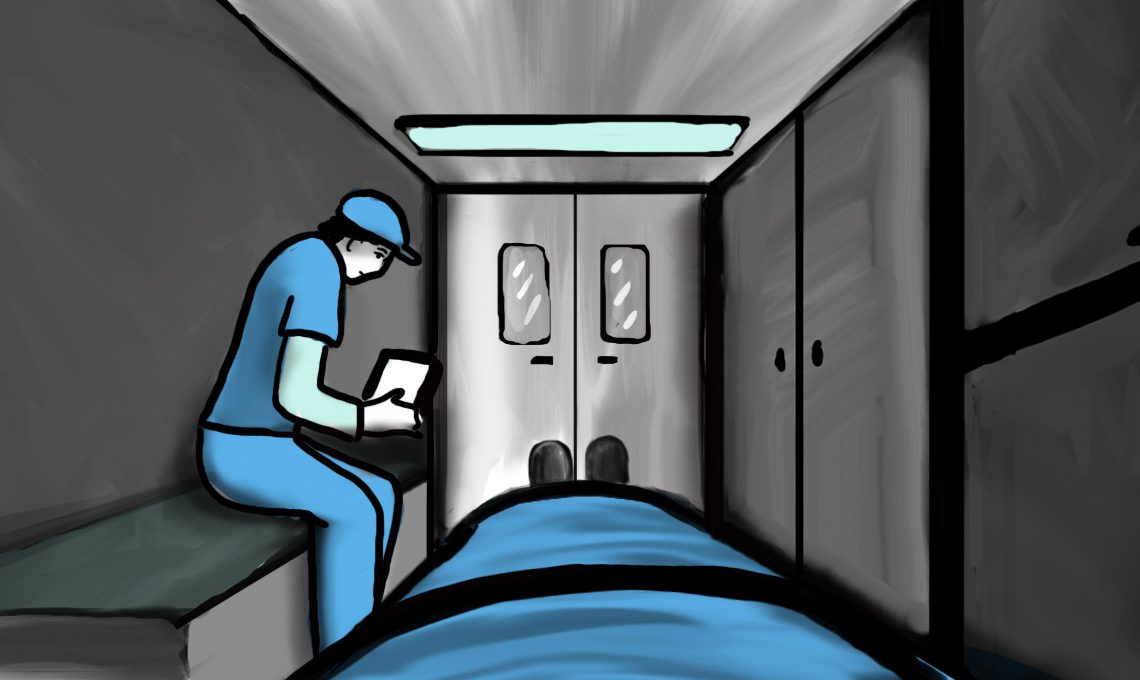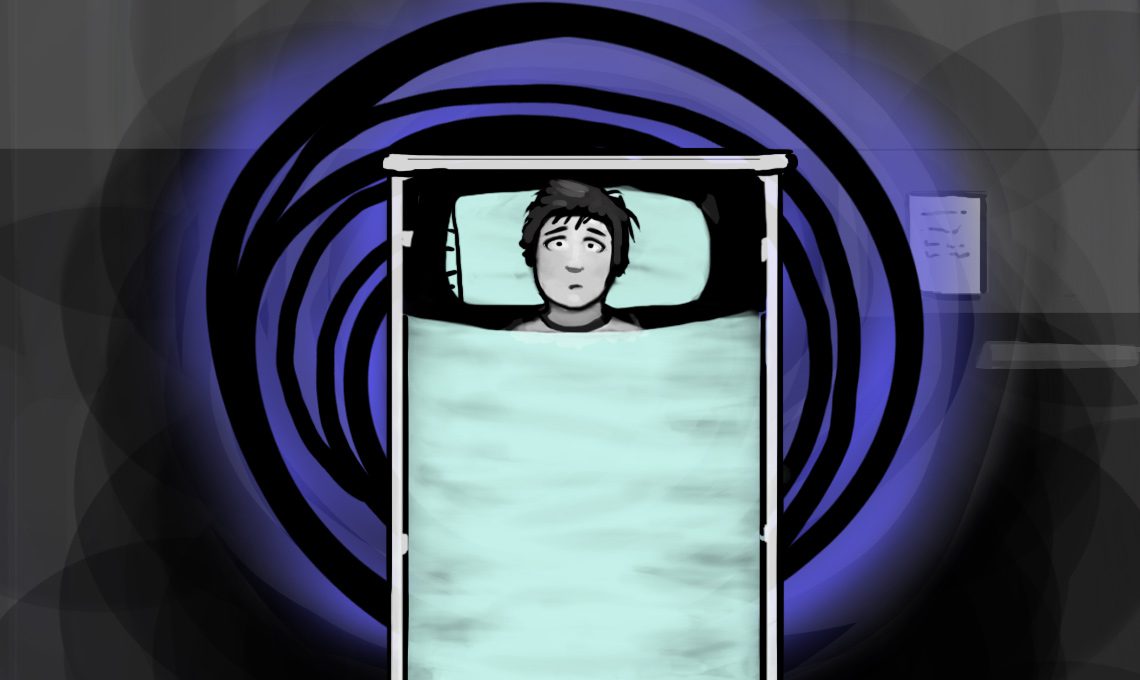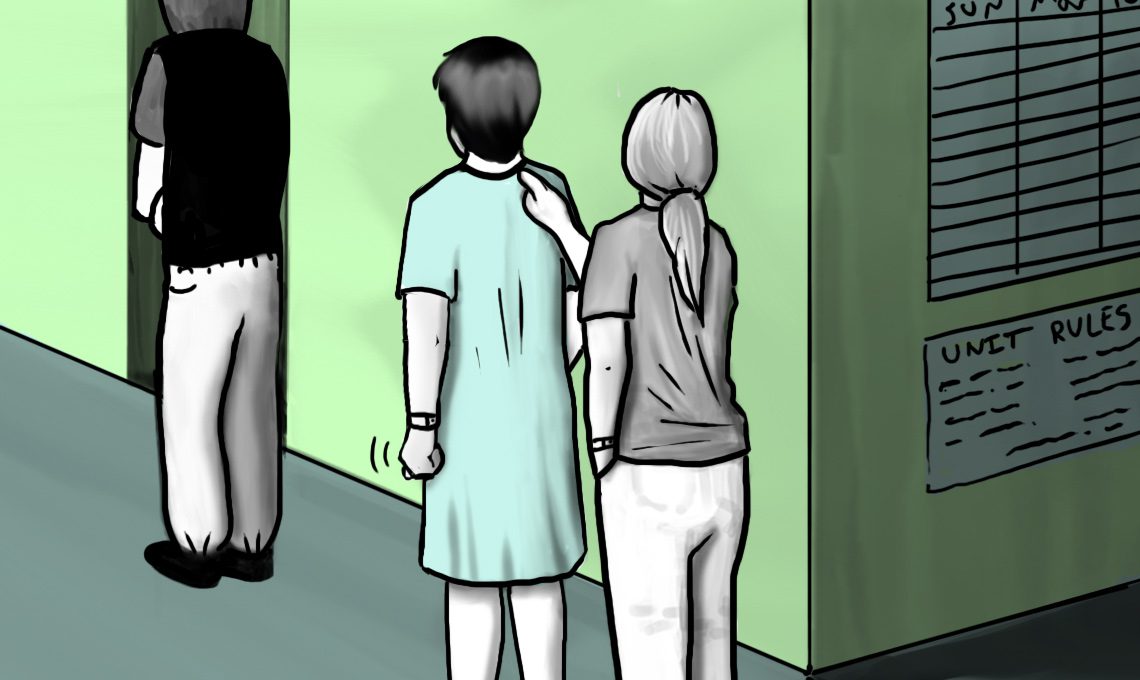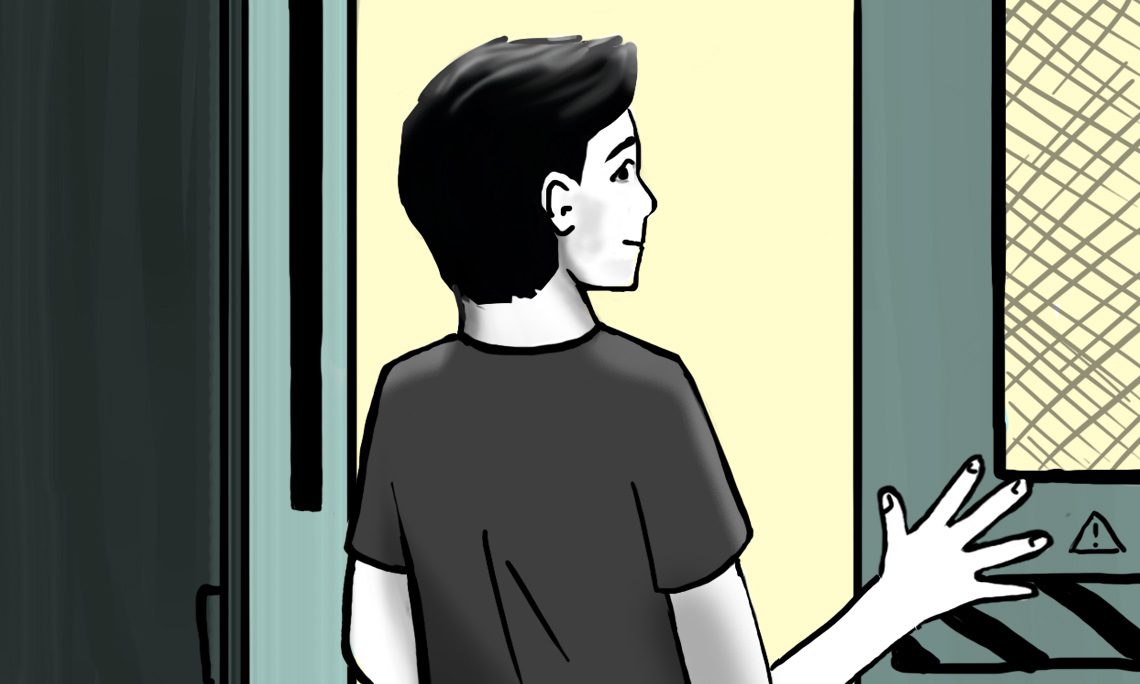 (Visuals by Desmond Meagley and Marjerrie Masicat.)
(Visuals by Desmond Meagley and Marjerrie Masicat.)

I remember the first time I was 5150’ed. It was an early December morning in 2011, a few days before my birthday, when I first climbed onto a gurney. I hugged my mom goodbye before the EMTs strapped me in, rolled me into an ambulance, and whisked me away.
Twenty-four hours later, I was in a behavioral health facility (or as they’re more commonly referred to, a mental hospital) in another city for a temporary involuntary commitment. Being 5150’ed meant I would be held at a hospital for at least 72 hours, or longer if the doctor assigned to my case decided that was necessary, whether I wanted to be there or not.
Before my gurney was wheeled into the psych ward through the heavy alarmed doors, I had to remove my clothing and exchange it for a hospital gown. Every item I had on my person would be searched for potentially hazardous objects — things like hoodie strings, shoelaces, even the spiral-bound spine of a notebook. These, along with electronic devices, would be confiscated until I was discharged.
Find resources and more stories that go #beyondselfcare to start a new conversation about mental health.
As I stuffed my clothes into a large drawstring plastic bag marked “PATIENT BELONGINGS,” it all felt unreal. I had never been hospitalized before for any reason. Part of me felt it was necessary, and part of me wasn’t so sure. The rest of me was just scared. And I couldn’t help but wonder, what would I find when I got inside?
“The Best Years Of Your Life”

Let’s back up for a moment. How did I end up in a mental hospital at 14 years old? It had started years before then. As I approached middle school, I appeared to be growing into your typical angsty preteen. I didn’t really enjoy going to class; I all but ignored my homework; I spent most of my time in my room; I preferred to be alone.
But under the surface, I was dealing with feelings that set me apart from my peers—intense body dysmorphia and gender dysphoria. I felt lonely and misunderstood by my classmates. I constantly worried about what the future would look like. I felt exhausted all the time, but it was so hard to sleep at night.
I started trying to talk about these symptoms with my parents, my friends, and my teachers before I was technically a teenager. I started taking medicine for my insomnia, but in response to my emotional concerns, I mostly heard remarks about how I was entering “the best years” of my life. Nobody seemed to take it seriously.
After I had a meltdown in the middle of my sixth grade class, my school gave my family an ultimatum: if I was going to be enrolled there, I also had to be in therapy. Just like that, my struggle to be heard was confined to dimly lit sessions with the school counselor and an outside therapist. I tried to be honest with them, but I was a little too young to grasp what was at the root of my mental health issues. I was also scared of what might happen if I was *too* honest.
I was getting used to pushing my mental health aside, believing that I would eventually grow out of my depression and anxiety… even though they were getting worse.
That’s the thing about chronic mental illness: you don’t grow out of it. It grows with you, getting smarter, more mature, more convincing. Constantly having to outsmart the worst parts of your own brain is a nightmare.
Fast forward to my freshman year of high school: 2011. I had just come out as trans, and I was trying to keep my head up and find friends in a brand new school. It was a highly sensitive time for me when my grandfather abruptly passed away, just before Thanksgiving.
I didn’t know my grandfather very well, but I wish I had. I come from a very small family. I’d always assumed that I would have time to develop a closer bond to him in my young adulthood. Suddenly he was gone. I felt devastated, unbearably guilty, yet totally numb. That was around when I first started cutting.
Then, one night, I made one of those Facebook posts. You know the kind I’m talking about: a melodramatic, vaguely self-threatening status update, clearly written to make others concerned for my safety and reach out. Call it attention-seeking if you want. But I needed help, and I felt blocked from finding it in a meaningful way. It was an immature act, because I was quite literally an immature person, who was desperate for a reason not to listen to the urges I was having.
I watched the comments on the post closely. First, one of my classmates made a joke about it. Then another privately messaged me and suggested I seek help.
I decided to choose the help.
I woke up my mom, sat next to her in bed, and told her that I was having thoughts of suicide. Without questioning me, she drove me to the emergency room, where I ended up repeating my story to the triage nurse, and then a crisis counselor.
We were there far past midnight. Eventually, I got the news: congratulations, I was officially institutionalized–temporarily. The 72 hour hold would start as soon as they had a bed for me.
And then there I was, the disoriented and scared new kid in the ward, surrounded by mint-green walls, prints of watercolor orchids, and fluorescent lights.
Summer Camp For Screwed Up Kids

I once heard someone say that adolescent psych wards are like summer camps for really screwed up kids. I would describe it more like a public school, a jail, and a rehab facility, all squeezed together into one building.
Mental health hospitalizations are becoming a more common part of young people’s growing-up stories. In California, mental health hospitalizations for people 21 years old and younger increased 38 percent between 2007 and 2012, rising from 34,000 to 47,000.
So I wasn’t just screwed up. I was “on trend.”
The first night I spent in the mental hospital, I kept thinking I had made a huge mistake, spiralling into self-resentment.
“You’re only here because you want special treatment,” I told myself.
“Everyone feels this way sometimes, and they just deal with it. Why can’t you just deal with it?”
“Stop making your problems into everybody else’s problems.”
“Stop wasting hospital resources for the people who actually need them.”
“Having this on your records is going to affect you for the rest of your life in ways you don’t even understand yet…”
The thoughts went on and on. I didn’t know this at the time, but plenty of hospitalized teens struggle with these feelings, especially on their first visit. Guilt, shame, fear of the future, and self-doubt are all common symptoms of anxiety and depression.
It wasn’t until I started talking to the other kids in the hospital that I realized I wasn’t out of place at all.
During my stay, I had to follow a strict schedule: wake up early, take pills in the morning, have breakfast, and go to group therapy with all the other patients. Next came recreational activities, lunch, more therapy, and maybe I’d get to go outside. Then dinner, more therapy, and going to bed on time. Somewhere in there, once every day or two, I’d get pulled out to see a psychiatrist.
The most unexpected part of the treatment, though, wasn’t the structure. It was the other patients: all teenagers, many with self-harm scars, talking openly about overdose, eating disorders, and abuse with little reservation.
People Who Knew

The first conversation I had in the hospital started when a girl behind me in the snack line asked me why I was there.
“Uh, I want to kill myself.” I said, a little embarrassed. It felt like such a cliché to say at that moment. Definitely too dramatic for someone who was standing around waiting for a cup of applesauce.
She didn’t miss a beat. “Me too! And I have manic episodes,” she said.
I didn’t know what those were, but the way she said it was super cheery.
“Why are you wearing that sock like that?” She asked, pointing to the thin cotton wrapped around my forearm. Earlier, I had ripped open the toe seam on a cheap hospital sock, so I could wear it like a sleeve and avoid looking at the angry red marks underneath.
“They haven’t given me my clothes yet. It’s to cover up my cuts,” I said.
She smiled. “You don’t have to hide them,” she said. “Nobody else here does.”
Her positive attitude surprised me. But as the day went on, I slowly began to adjust, and I realized that most of the other teen patients didn’t act “mentally ill” at all.
I had kind of expected to be among caricatures of crazy, sick people; medicated, shuffling around in white gowns, intermittently screaming, fighting, or talking to themselves. But in another setting, like a classroom, they would have looked and sounded like any other group of teens — not young people struggling with depression, addiction, eating disorders, and more. They looked like me.
Nearly everyone I met was stunningly transparent about their personal lives. And it encouraged me to be transparent too.
I made friends who had been 5150’d for the first time ever and others who had been hospitalized too many times to count, for whom it was almost part of normal life. Unlike “real life,” we all knew that each person there was struggling with something huge and painful, and that we should seek to respect and understand each other.
The first time I was hospitalized, I was committed for a week in total, just in time to celebrate my fifteenth birthday there. And despite the frequent arrivals and departures of patients, I felt so much implicit trust and empathy among the other young people I was hospitalized with.
Like with any group of teenagers, it came with its share of drama, too. Romantic relationships formed and fell apart despite staff efforts to prevent them. Rumors spread and caused arguments. People crossed each other’s boundaries and triggered each other sometimes. But I had seen worse behavior among my (presumably) mentally healthy classmates and friend groups before. In high school, I couldn’t go two months without witnessing or hearing about a full-on fistfight.
My mental health issues had always made me feel alienated from other people my age. But in the hospital, opening up was how I made friends. The more honest I was, the more I was able to face my own trauma and the impact it was having on my life. Suicidal thoughts had been my constant elephant in the room—at school, at home, and with my friends. I knew few, if any, people who were equipped to talk with me about my suicidality in an effective, measured way.
Living with suicidal thoughts is draining and all-consuming, and yet it also becomes mundane, even comical at times. You’d only know if you’ve been through it. I was finally surrounded by people who knew.
It Just Really Sucks

Plus, we all bonded over how much being institutionalized sucks. It really just sucks, man.
You have to wake up early every day, and each minute is rigorously scheduled. “Outside time” is limited to one or two half-hour periods each day. If you don’t follow the schedule, you can have certain privileges taken away. Refuse to get up at 7:00 a.m.? Say goodbye to your phone calls and visitor time.
And to top it all off, hospital food is seriously gross. For a place that treats major depression, it’s majorly depressing.
During my first hospital stay, I was assigned to a psychiatrist who quickly diagnosed me as bipolar. Based on my depression and suicidality, he prescribed me an antipsychotic to prevent manic episodes. I still didn’t know what those were, and hadn’t (to my knowledge) ever experienced one.
Two of my friends on the ward—super cheery girl not included—told me that the same doctor had diagnosed them as bipolar, too. They were on the same medication as I was, for the same reasons, even though they didn’t have manic episodes either. Then, when the psychiatrist met my parents for our first family therapy session, he started to claim that my father was bipolar. Even my grandmother was likely bipolar, he insisted, after hearing anecdotes about my grandparents. He sounded almost like a conspiracy theorist.
Though I was obviously skeptical of his conclusions, there wasn’t much I could do to advocate for myself. The psychiatrist didn’t listen when I told him that I thought he was making a mistake. But if I refused to go to sessions with him or take the medication he’d prescribed, I would have had privileges revoked until I complied with my “treatment plan.” (Fortunately, my regular doctor took me off of the antipsychotic as soon as I was released home.)
Another problem is that hospital bedrooms are segregated by sex, and usually patients are assigned a roommate. To a suicidally dysphoric transgender person, this is an excruciating rule. If there weren’t enough beds available for me to have my own room, I had to room with someone based on my assigned sex, or else sleep in the “Quiet Room”— a small room with no furniture, just a bed with straps and a camera pointed at it. Try getting a good night’s rest in a room like that.
There’s a Quiet Room at every mental hospital I’ve been to. If a patient has a violent or aggressive episode, they’re sedated with an injection and strapped down to the bed in the Quiet Room until they calm down.
During my first full day at the hospital, my new friends in the ward informed me that this was known as “booty-juicing,” since the injection is delivered to the rear end. (I heard this term at every hospital too. Unsurprisingly, youth in psych wards use dark humor all the time to cope with their situations.)
I only witnessed one person get booty-juiced. It’s funny to say, but scary to see. One big dude started raising his voice and pushing a nurse. In an instant, five or six huge hospital security guards surrounded him, and he dropped to the ground. Before I fully realized what had happened, it was over and the guy was gone. To be honest, I’m not sure which part I found more unsettling: the teen’s outburst, or the way security had subdued him like a wild animal.
Saying Goodbye, and Making It

After that initial stay, I was 5150’d three more times over the next three years. I can’t make up my mind whether the treatments helped me or hurt me in the long term. Each time, the other kids reminded me I wasn’t alone, and the hospital visits did provide an immediate intervention for me when I was in danger. But I would also depart with a greater awareness that society treats mental illness as a legitimate excuse to disregard the needs and desires of the vulnerable.
It’s been almost four years since the last time I was admitted. I’m not in crisis anymore, but I’m aware I’m managing a chronic mental illness that requires continued maintenance. I also have a more profound understanding of myself and others who face the same mental health struggles that I do, because of my time in the hospital.
Plus, I’ve become viscerally aware that 72 hours can’t fix my problems. I have to care about myself enough to take responsibility for my own health at all times. (It’s not easy, but it’s the only way.)
On the day they left the hospital, folks would always trade contact information with the friends they had to leave behind, even though the staff generally discouraged this. It’s bittersweet, spending days opening up to strangers and forging friendships, just to walk away with no guarantee of ever seeing them again. Nobody wants to abruptly sever a bond like that, but everyone has to move on at some point.
I’m actually still connected with a few people I met in the hospital through various social media platforms. I enjoy getting little snapshots of their continued existence: their friends, their selfies, their iced coffee drinks, and in some cases, their children(!). We interact very little, outside of the occasional “like” on a photo. I often think about how they’re doing on the other side of the screen, but I don’t think leaving these friendships in the past is necessarily a bad thing.
People who struggle with mental illness in childhood and adolescence deserve to grow up and live lives that aren’t defined by their traumatic experiences. And that goes for me, too.